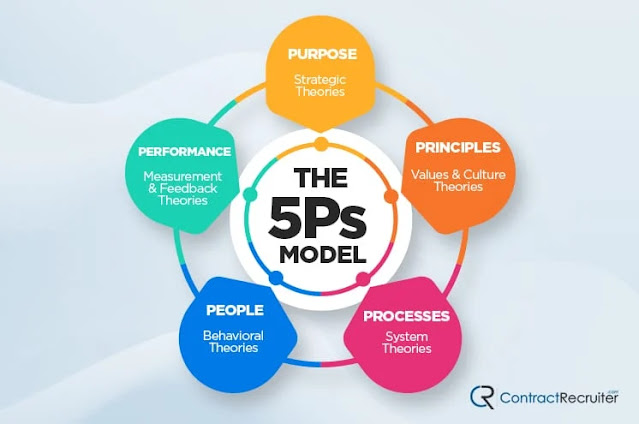This model was developed by Mildred Golden, Chris J. White, and Leslie A. Toombs. This can be identified as a strategic management model that helps the alignment of five key variables to improve the organization and its operations. This model defined five P categories that influence the overall behavior of human resources (Mayrhofer et al., 2019).
Steps for the 5 P’s Model implementation:
- Purpose - Identify the main strong points, weak points, opportunities, and threats, and identify the mission, vision, goals, and organizational strategies.
- Principles - Identify organizational culture and values.
- Processes - List all processes and draw them using flux grams, process maps, etc; identifying those responsible for each process.
- People - Determine which measures people are qualified for the duties they perform; identify the training needs.
- Performance - Identify used performance measures; establish key performance indicators (KPIs); set up a metric system.
According to Figure 2, it shows the connection between strategy (Purpose) and structure (Principles as internal structures and Processes as external structures) and the influence of structure on employee behavior (People) and corresponding results (Performance). As reflected in this graphic, strategy drives the structure; structure drives behavior; and behavior drives results (Pryor et al., 2019).
Conclusion
In conclusion according to the 5P’s HRM Model, organizational performance directly depends on the performance of people engaged in processes and guided by organization purposes and principles.
References
- GREENBERG, A. 2021. The Ultimate Guide to Human Resources Models and Theories. Available from: https://www.contractrecruiter.com/human-resources-models-theories/ [Accessed 4/29/2022].
- MAYRHOFER, W., GOODERHAM, P. N. & BREWSTER, C. 2019. Context and HRM: Theory, Evidence, and Proposals. International Studies of Management & Organization, 49, 355-371.
- PRYOR, M. G., DONNA ANDERSON, TOOMBS, L. A. & HUMPHREYS, J. H. 2019. Strategic Implementation as a Core Competency The 5P's Model. Journal of Management Research, 7.
- PRYOR, M. G., WHITE, J. C. & TOOMBS, L. A. 1998. Strategic Quality Management: A Strategic, Systems Approach to Continuous Improvement, Mason, OH., Thomson Learning.


This article discusses an important model of HR which focuses on five constitutional aspects: purpose, principles, processes, people, and performance. According to this model, proper management of these functions will enable to achieve organisational success. Good article to improve our knowledge. All the Best Mafaz!
ReplyDeleteThank you, Dilini!
DeleteFor an organization to be efficient and productive, all five variables must be in sync in order for them to mutually support and reinforce each other. Your article describes important aspects related to the 5P model. Good Luck
ReplyDeleteThank you, Venushka!
DeleteThis article outlines a key HR model that focuses on five key elements: purpose, principles, procedures, people, and performance. This model states that good management of these functions will lead to organizational success. This is an excellent article for expanding our understanding. Best wishes
ReplyDeleteThank you, Lakshitha!
DeleteThe main advantage of this model is that you can get real-time feedback. This will help the decision makers to reveal hidden issues and find solutions quickly. Thanks for sharing these valuable points with us. Good Luck!
ReplyDelete5P's, how it could effect the organizational performance, well explained article giving a clarity to the employees and organization to implement and measure accordingly.
ReplyDelete